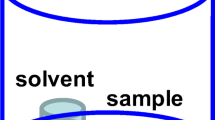Abstract
A novel bridged organosilane precursor with star-shaped construction, [hexfluoropropane-2,2-diyl)dibenzyl-bridged organosilane (HFPDBO)], is prepared by facile organic synthesis method. The resultant HFPDBO precursor is mixed with porogen and acid catalyst to prepare periodic mesoporous organosilica (PMO) thin film via evaporation-induced self-assembly after spin-coating procedure. All the as-prepared HFPDB-based PMO thin film has been characterized by Fourier transform infrared spectroscopy, nuclear magnetic resonance spectrum, scanning electron microscopy, transmission electron microscope, and small-angle X-ray diffraction, respectively. Thereinto, the HFPDB-based PMO thin film with weight ratio of porogen to precursor (0.75:1) possesses excellent dielectric property (1.58@1 MHz of dielectric constants), high mechanical property (5.54 ± 0.11 GPa of Young’s modulus) and hydrophobic property (90.1° of water contact angle) simultaneously. These low dielectric constant, high mechanical strength, and the hydrophobicity suggest potential application of the HFPDB-based PMO thin films as low-k materials in microelectronics.









Similar content being viewed by others
References
Martin SJ, Godschalx JP, Mills ME et al (2000) Development of a low-dielectric-constant polymer for the fabrication of integrated circuit interconnect. Adv Mater 12(12):1769–1778
Shamiryan D, Abell T, Iacopi F et al (2004) Low-k dielectric materials. Mater Today 7(04):34–39
Vora RH, Krishnan PSG, Goh SH et al (2001) Synthesis and properties of designed low-k fluoro-copolyetherimides. Part 1. Adv Funct Mater 11(5):361–373
Morgen M, Ryan ET, Zhao JH et al (2000) Low dielectric constant materials for ULSI interconnects. Annu Rev Mater Sci 30(1):645–680
Mcgahay V (2010) Porous dielectrics in microelectronic wiring applications. Materials 3(1):536–562
Grill A, Neumayer DA (2003) Structure of low dielectric constant to extreme low dielectric constant SiCOH films: Fourier transform infrared spectroscopy characterization. J Appl Phys 94(10):6697–6707
Kikuchi Y, Wada A, Kurotori T et al (2013) Non-porous ultra-low- k SiOCH (k = 2.3) for damage-free integration and Cu diffusion barrier. J Phys D-Appl Phys 46(39):395203–395209
Xu J, Moxom et al (2002) Porosity in porous methyl-silsesquioxane (MSQ) films. Appl Surf Sci 194(1):189–194
Lee HJ, Soles CL, Liu DW et al (2004) Structural characterization of porous low-k thin films prepared by different techniques using x-ray porosimetry. J Appl Phys 95(5):2355–2359
Geng Z, Huo M, Mu J et al (2014) Ultra low dielectric constant soluble polyhedral oligomeric silsesquioxane (POSS)–poly(aryl ether ketone) nanocomposites with excellent thermal and mechanical properties. J Mater Chem C 2(6):1094–1103
Goethals F, Ciofi I, Madia O et al (2012) Ultra-low-k cyclic carbon-bridged PMO films with a high chemical resistance. J Mater Chem 22(17):8281–8286
Maex K, Baklanov MR, Shamiryan D et al (2003) Low dielectric constant materials for microelectronics. J Appl Phys 93(11):8793–8841
Hatton BD, Landskron K, Hunks WJ (2006) Materials chemistry for low-k materials. Mater Today 9(3):22–31
Makoto S, Wendong W, Lofgreen JE et al (2011) Low-k periodic mesoporous organosilica with air walls: POSS-PMO. J Am Chem Soc 133(45):18082–18085
Huang Y, Economy J (2006) New high strength low-k spin-on thin films for IC application. Macromolecules 39(39):1850–1853
Lu HY, Teng CL, Kung CH et al (2011) Preparing mesoporous low-k films with high mechanical strength from noncrystalline silica particles. Ind Eng Chem Res 50(6):3265–3273
Hunks WJ, Ozin GA (2005) Challenges and advances in the chemistry of periodic mesoporous organosilicas (PMOs). J Mater Chem 15:35–36
Wills AW, Michalak DJ, Ercius P et al (2015) Block copolymer packing limits and interfacial reconfigurability in the assembly of periodic mesoporous organosilicas. Adv Funct Mater 25(26):4120–4128
Hoffmann F, Cornelius M, Morell J (2006) Silica-based mesoporous organic-inorganic hybrid materials. Angew Chem Int Ed 45(20):3216–3251
Barbara P, Andreas K, Thomas B (2011) Mesoporous structures confined in anodic alumina membranes. Adv Mater 23(21):2395–2412
Edelstein D (2008) Extendibility of Cu/low-k/airgap BEOL. Electrochem Soc 28:2073
Hatton B, Landskron K, Whitnall W et al (2005) Spin-coated periodic mesoporous organosilica thin films—towards a new generation of low-dielectric-constant materials. Adv Funct Mater 15(5):823–829
Jiang T, Zhu B, Ding SJ et al (2014) High-performance ultralow dielectric constant carbon-bridged mesoporous organosilica films for advanced interconnects. J Mater Chem C 2(32):6502–6510
Liu HC, Su WC, Liu YL (2011) Self-assembled benzoxazine-bridged polysilsesquioxanes exhibiting ultralow-dielectric constants and yellow-light photoluminescent emission. J Mater Chem 21(20):7182–7187
Wang W, Lofgreen JE, Ozin GA (2010) Why PMO? Towards functionality and utility of periodic mesoporous organosilicas. Small 6(23):2634–2642
Driessche IV, Der Voort PV (2013) Sealed ultra low-k organosilica films with improved electrical, mechanical and chemical properties. J Mater Chem C 1(25):3961–3966
Yuan H, Xu J, Xie L (2011) Ultra low-dielectric-constant methylated mesoporous silica films with high hydrophobicity and stability. Mater Chem Phys 129(3):1195–1200
Rathore JS, Interrante LV, Dubois G (2008) Adv Funct Mater 18(24):4022–4028
Fiorilli S, Camarota B, Garrone E (2011) Carboxylic groups in mesoporous silica and ethane-bridged organosilica: effect of the surface on the reactivity. Phys Chem Chem Phys 13(3):1201–1209
Wang W, Grozea D, Kohli S (2011) Water repellent periodic mesoporous organosilicas. ACS Nano 5(2):1267–1275
Grosso D, Cagnol F, Soler-Illia GJAA (2004) Fundamentals of mesostructuring through evaporation-induced self-assembly. Adv Funct Mater 14(4):309–322
Acharya A, Sanyal SK, Moulik SP (2001) Physicochemical investigations on microemulsification of eucalyptol and water in presence of polyoxyethylene (4) lauryl ether (Brij-30) and ethanol. Int J Pharm 229(1):213–226
Landskron K, Hatton BD, Perovic DD (2003) Periodic mesoporous organosilicas containing interconnected [Si(CH2)]3 rings. Science 302(5643):266–269
Pai RA, Watkins JJ (2006) Synthesis of mesoporous organosilicate films in supercritical carbon dioxide. Adv Mater 18(2):241–245
Solymosi F, Bánsági T (1979) Infrared spectroscopic study of the adsorption of isocyanic acid. J Phys Chem 83(4):552–553
Acknowledgements
This work was financially supported by National Natural Science Foundation of China (Grant No. 21201175), Guangdong and Shenzhen Innovative Research Team Program (No. 2011D052, KYPT20121228160843692), and R&D Funds for basic Research Program of Shenzhen (Grant No. JCYJ20120615140007998, JCYJ20150401145529012).
Author information
Authors and Affiliations
Corresponding authors
Electronic supplementary material
Below is the link to the electronic supplementary material.
Rights and permissions
About this article
Cite this article
Zhang, J., Zhang, G., Gao, Y. et al. Ultra-low-κ HFPDB-based periodic mesoporous organosilica film with high mechanical strength for interlayer dielectric. J Mater Sci 51, 7966–7976 (2016). https://doi.org/10.1007/s10853-016-0066-6
Received:
Accepted:
Published:
Issue Date:
DOI: https://doi.org/10.1007/s10853-016-0066-6




